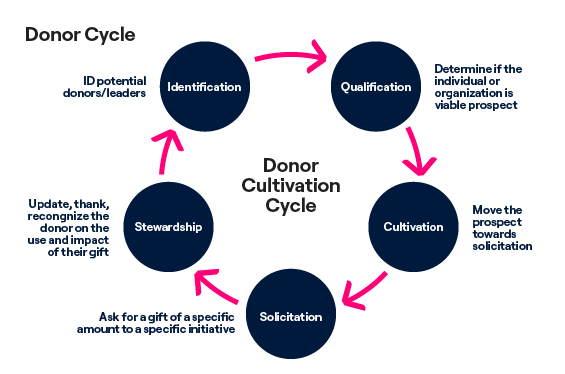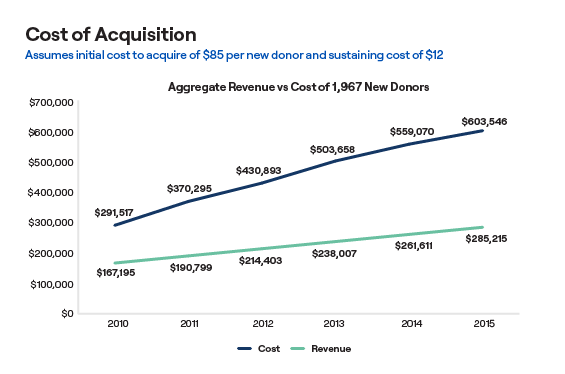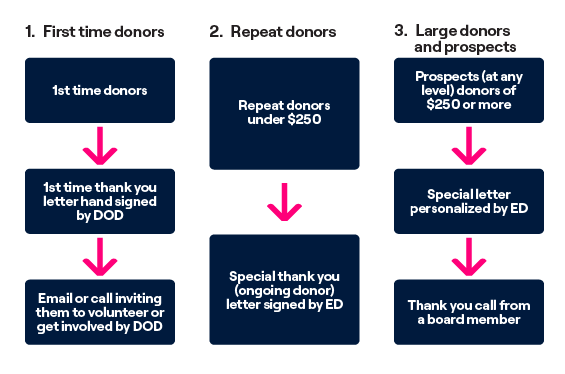In times when operational costs for organizations are increasing and donor prospects are lower, the need for a donor retention strategy takes on renewed importance. With the unpredictable economic environment and evolving business, finding ways to communicate effectively and retain donors is crucial. Donor retention is part of the ongoing donor process. It includes identifying prospects, building relationships, and donor stewardship.
Donor stewardship is the process that occurs once a donor has given to your organization. Stewardship refers directly to the continued communication and relationship building that happens after the initial transaction, which directly affects your donor retention rate.
This article covers the importance of donor stewardship in order to maintain donor retention, explains why donor retention is economically beneficial compared to acquiring new donors and how it increases your organization’s rate of return (ROI). The critical components of a consistent messaging plan to facilitate keeping donors informed of the impact their donations are having on the cause they care about and highlighting your organization’s continued appreciation for their support is explored in detail.
Keep reading to explore:
- Building and Maintaining Donor Relationships
- The Importance of Communicating the Impact of Donations
- Communication Strategies for Retaining Donors
- Developing and Implementing a Successful Donor Stewardship Program
Get more from your donor relationships

- Start donor prospecting
Donor cultivation is the process of identifying and engaging with possible prospects, sharing your organization’s mission, and beginning to build a relationship before requesting a gift. Donor qualification determines which potential donors have the ability to give to your organization, and at which level they can be expected to contribute. WealthEngine’s wealth modeling feature works to help determine the status of each prospect, so you can easily identify which areas of your organization will appeal to them and which level of contribution is the best fit.
The donor cycle begins as soon as a prospect is identified. Help these potential donors familiarize themselves with your organization’s mission, and explain why your cause is relevant to each donor. WealthEngine’s Engagement Science feature allows you to utilize personalized information and interact with your donors through targeted campaigns designed to increase engagement.
Insights provided by the WealthEngine comprehensive platform dig deeply into the lifestyle of your donors, so you can understand what motivates them, which allows your organization to create meaningful relationships centered around your mission and your donors’ interests. By analyzing relevant wealth and lifestyle signals, WealthEngine gives you the necessary tools to personalize your campaigns and boost your donor engagement.
Once you have utilized this information to appropriately target your messaging, continue the conversation, and explain why their contribution is important. Provide examples of the impact their support will have and make it clear where their gift will be going. This provides your donors with a clear understanding of their impact. Remember, it is important to find ways to personalize your message to make it relatable to each donor.
- Build better donor relationships
Once a relationship has been established, it is crucial to continue nurturing a connection between the donor and the organization. Focus on keeping an open line of communication with supporters through consistent emails and newsletters featuring updates of your work and achievements.
It is vital that the relationship between your organization and its donors be one built on two-way communication. Use all of your communication channels to solicit donor feedback through interactive surveys, polls, and reviews, and be sure to announce when elements of initiatives contain suggestions gleaned from donor feedback. This will demonstrate to your donors that their suggestions are listened to and when viable, acted upon.
Invite donors to events or activities your organization is hosting so they can witness how their gifts are being used. Donor engagement will increase the likelihood of recurring gifts while strengthening your relationships with donors, which will encourage them to remain active participants in your organization.

- Increase your donor retention rate
Once a relationship has been established, donor retention is the process of retaining donors and keeping them involved in your organization after their initial gift. The goal of donor retention is to have donors give more than once and see these donors become more involved with your cause.
Using the model above as an example, assume the initial cost to acquire a new donor is $85 while the cost of sustaining donors is $12. This graph illustrates how donor retention is economically necessary for a nonprofit to survive, as sustaining donors is significantly less expensive than acquiring new ones.
The average year-on-year donor retention rate in the United State is 46%, which shows that less than half of all donors remain active after their first contribution. This low percentage illustrates how easily money is lost through poor retention rates, as the cost to onboard new donors is greater than the cost of sustainment.
It is also worthwhile to seek out donors who can donate their time to initiatives. Just because a donor’s financial outlook may not make them a promising cash donor does not mean that the resources they could bring to the organization as a valued volunteer should be overlooked.
The continued cycle of donor cultivation and stewardship is vital because sustaining current donors has a positive effect on your organization’s return on investment (ROI), and plays a crucial role in your organization’s survival. Maintaining relationships and encouraging donor engagement leads to a higher ROI as your sustainment costs continue to lower and your revenue stream increases during a donor’s lifetime involvement in your mission.
By continuing the donor cycle past the first gift through communication and strategic donor engagement, the experience donors have with your organization can improve, and your donor retention rate will increase.
Talk about the impact of donations
So you’ve received a donation, now what? Making sure your donors see how their gift is supporting your cause will be vital in retaining them for future contributions. Some organizations give the option for donors to specify where they would like their donation to be used. Finding ways to showcase these impacts can strengthen the donor relationship.
Start with a plan for communicating the value of each donation. Share the ways these contributions are being used to sustain your organization’s guiding mission, while also enabling the pursuit of important new endeavors that align with the values of the organization.
Continually emphasize how the generosity of your donors makes these actions possible. In the digital age, it is easier than ever to keep in touch with donors, so you can easily focus your social media messaging to showcase the impact that is being made to benefit your cause.
It’s also extremely important not to forget the importance of personal contact. Send a handwritten note thanking your donors for their gifts; have a plan for you or someone from your team to speak with them personally when they attend events, and make a point of discussing all the ways their donations are being used, being sure to listen to any suggestions donors may wish to share. Making the effort to meet and speak with them as individuals and discuss the progress the organization is making thanks to their generosity can make all the difference when it comes to donor retention.
Communication strategies for retaining donors
Communication is the most important factor when working to retain donors. Focus on maintaining early contact with your donors. Personalization is also vital in nurturing the donor relationship and small acts such as remembering to acknowledge and express gratitude to donors right away, with a quick post-gift follow-up, such as a brief phone call or a personalized email thanking them for their continued support, increases the likelihood the donor will continue to feel connected to your organization and its goals.
Timing is important, and maintaining consistent and efficient communication will ensure a donor feels seen and appreciated by your organization. Always let donors know that the important role they play in the organization’s success is appreciated and go out of your way to ensure each donor feels welcomed by your group.
Share meaningful content and a consistent narrative. When reaching out to donors to give updates on the impact their support is having, focus on driving your messaging through intentional content. Donors will appreciate, and most likely respond to, action-driven messages rather than fluff, and a consistent narrative illustrating how their gifts are being used will encourage continued donations to your organization.
Ask for donor feedback by conducting surveys and polls, and do your best to integrate their suggestions into your work. Don’t be afraid to use your communication lines to ask your donors what they think. Reach out and hold conversations with them, so you can tailor your communication strategies to their needs and avoid donor fatigue.
Develop and implement a successful donor stewardship program

As you continue to search for new prospects, and implement donor stewardship programs, start by gathering and analyzing your information. Create personalized campaigns, segment donors according to their financial capacity to give and their shared interests, based on insights gathered by WealthEngine 9’s analyze feature, which includes look-alike modeling, and use this information to create a plan to reach your target audience.
Find ways for donors to get involved beyond their initial gifts. Reach out when you need volunteers, especially if you have an event coming up that is being funded by their contributions, or when something exciting is happening within your organization.
Donors who are actively involved in initiatives will see the impacts of their gifts first-hand and feel inspired to continue giving, which increases your donor retention rate. Donors who give of their time also need to feel they have made impactful contributions and be shown that their endeavors are making a difference. Continually prioritize highlighting the impact donor support is having on the sustainability and success of your mission using every form of communication available.
Nonprofits, large and small benefit when they commit to increasing donor retention rate and prospecting. Find out how solutions like WealthEngine can help you amplify the impact for your team today.
